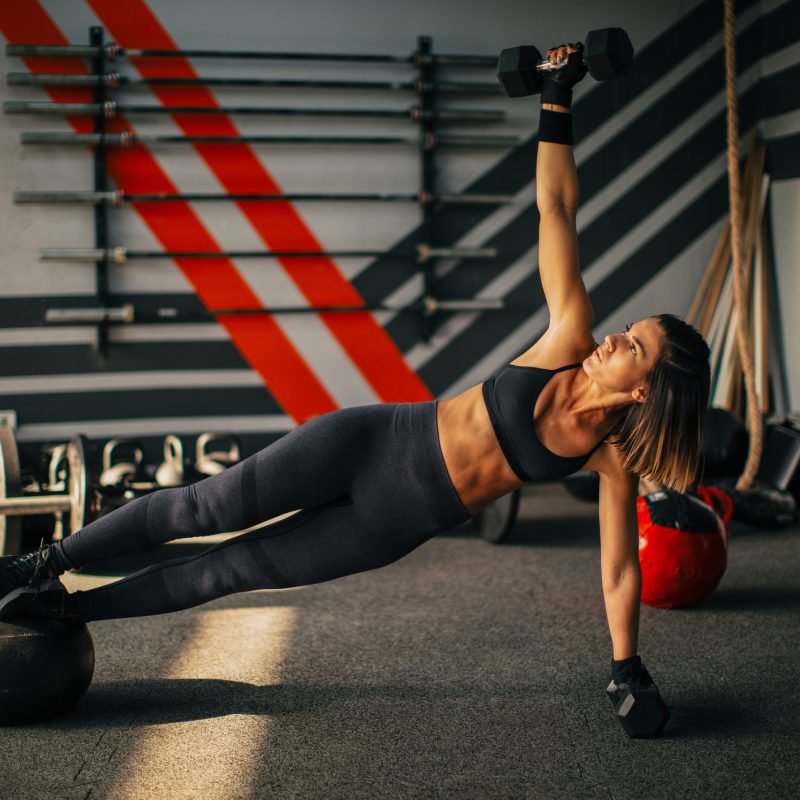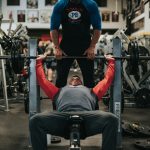
Imagine an intense soccer game: lots of running, kicking, and pivoting, all the typical elements of play, happening at top speed. The muscles taking the biggest hit, the adductors and abductors, as well as the obliques, need proper attention during training to avoid suffering a groin pull when participating in such sports. In this article, we introduce the Copenhagen plank. Developed by the FC Copenhagen soccer team, this exercise zeroes in on and challenges these specific areas. While not easy to master, this plank variation can easily fit into any legs and core training session.
Anatomy of a Copenhagen Plank
While traditional planks can work wonders on an athlete’s core, the Copenhagen plank elevates this challenge to an entirely new level with a simple mechanical lever alteration. The move resembles a side plank: lying on one side of the body, forearm resting flat on the floor, top arm elevated straight in the air, and legs fully extended. However, rather than simply placing one foot on the other, the top foot rests on a slightly elevated surface, no more than 18” high. The lower leg remains elevated just below the taller platform but definitely in mid-air.
Greater Benefits Than the Side Plank
The main difference between the merits of a traditional side plank and a Copenhagen plank lies in the latter’s ability to strengthen not only the obliques but hip abductors and adductors as well. These muscles control the movement of the leg either toward the midline of the body or away from it, and are recruited during all lateral movements. In addition, abductors act as stabilizers, keeping the knee from collapsing when balancing on one leg.
While maintaining the Copenhagen plank position, the core stabilizer muscles find themselves working overtime in an effort to keep the body in anti-rotational alignment. When the body’s support comes solely from the foot resting on the elevated surface, the obliques and other core muscles must rise to the challenge of preventing the body from rotating in a forward direction.
Weaknesses and Imbalances
Many individuals and budding athletes fail to realize or perceive the weakness of their adductors, which actually rank as among the most often neglected of the body parts during fitness training. Such awareness tends to arise only when one pulls a groin muscle. Since both the abductors and adductors serve to help stabilize the pelvis, we can easily understand that failure to provide sufficient support in this area often leads to lower back pain. Inclusion of the Copenhagen plank in regular training sessions can therefore foster stronger lower-body muscles and thwart potential injuries.
Muscle imbalances can benefit from the type of unilateral training offered by a Copenhagen plank. Serious imbalances that go unrecognized often lead to incongruous patterns of movement, which increase the risk of injury, according ACE (American Council on Exercise). If a client perceives a weakness on his left side, prioritizing Copenhagen planks on that side can, over time, help to even out strength imbalances.
Common Positional Errors
As with any great exercise, trainers often witness mistakes in form by individuals first attempting a Copenhagen plank. Mental visualization can help here. Try to envision the heels, glutes, and back of the head all remaining in contact with a wall. This forms the straight alignment for which one strives during this move.
Common errors include arching of the back, over-elevating the hips, and hyperextending the neck by focusing upward instead of down toward the floor. Arching the back in particular tends to shift the tension away from the core and into the arms, back, and legs, thereby leaving the lower back vulnerable to injury. To ensure against this, visualize the belly button pulling towards the ribcage throughout the entirety of the move.
Personal trainers might want to remind clients to avoid over-rotation of the shoulders when attempting a Copenhagen plank, especially when trying to hold the proper alignment for any length of time. The importance of ensuring a neutral spine, too, figures prominently during this plank variation, to avoid excess strain on one’s neck.
Perfect for Prehab and Rehab
Knowing that certain muscles in the body find themselves more prone to injury than some others — such as the groin area — strengthening them regularly can help ward off painful pulls and/or strains. This method of safeguarding, also known as “prehabbing”, keeps the body primed for any upcoming (or regularly engaged in) physical challenges.
Even if one does not engage in physically demanding sports such as soccer or rugby, adductors function prominently in many movements we encounter in our daily activities. With every step we take, each time we stand up (unassisted by the upper body) from a seated position, or any time we find ourselves standing on only one foot, we must engage and challenge the adductors. Also, adductors contribute greatly to hip stabilization. Considering that the hip region must perform the role of connecting the upper body to the lower portion, its stability and integrity will ultimately affect the body’s ease of movement.
For individuals who have suffered a sports-related injury, such as a groin pull, adductor strain, or various tendinopathies, Copenhagen planks serve an important purpose in most rehabilitation programs.
Posture and Spine Positioning
As much as trainers preach the importance of physical activity for a healthy lifestyle, today’s world tends to find itself increasingly sedentary. This can happen with office jobs and/or an excessive amount of time spent looking at a cell phone/iPad screen. Good posture holds neck and lower back injuries at bay; strong adductors can contribute significantly to maintaining proper posture.
Since the Copenhagen plank focuses greatly on pelvic stability, it likewise ultimately affects the alignment of one’s spine. A healthy, strong, and flexible spine forms the solid foundation for good posture; once mastered, better posture can lower the risk of backaches, neck strains, and other musculoskeletal issues.
Any Time, Any Place
The Copenhagen plank relies on easily accessible equipment; the elevated surface upon which the top foot rests does not necessarily have to originate in a gym or fitness center. Any chair, sofa, bench, or even a box can serve this purpose. This makes the Copenhagen plank an ideal exercise for those on the go, whether at home, in a hotel room, or even following a hike in any park with benches (or stable low tree limbs). Sometimes the simplest exercise moves can turn into the most challenging and helpful things we can do to keep ourselves in peak physical condition.
References
https://theprehabguys.com/why-you-should-do-copenhagen-planks/






